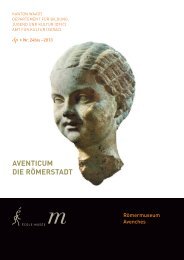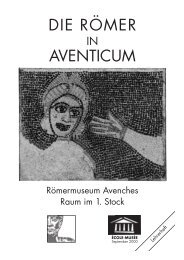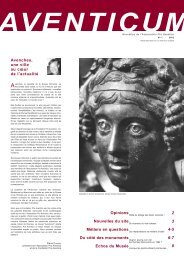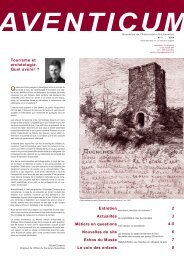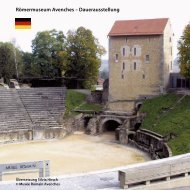Avenches – Roman Museum – Permanent Exhibition
Avenches – Roman Museum – Permanent Exhibition
Avenches – Roman Museum – Permanent Exhibition
You also want an ePaper? Increase the reach of your titles
YUMPU automatically turns print PDFs into web optimized ePapers that Google loves.
First Floor From Late Antiquity to the Early Middle Ages<br />
From Late Antiquity to the Early Middle Ages<br />
(Display case 25)<br />
Around the mid 3rd century, the <strong>Roman</strong> Empire began to show signs of a general<br />
weakening. The incursions of the Alamanni in the Swiss midlands from AD 260<br />
onwards, stopped Aventicum from prospering, but did not totally destroy the town.<br />
In our region the <strong>Roman</strong> reign officially ended in AD 455 when Rome gave up its<br />
Germanic provinces. The town retained a certain regional importance and was a<br />
bishop’s see until AD 594.<br />
From the late 3rd century onwards, the inhabited area of Aventicum shrank<br />
to the section between the western gate, the theatre and the amphitheatre.<br />
Archaeological finds dating from the 4th , 5th and 6th centuries are rare. Only a small<br />
number of architectural structures have been found. The fragments of a wall coating<br />
(display case 25, nos. 1-4) show a marble decoration, which may have belonged to a<br />
church or an official building dating from the late 4th or from the 5th century AD.<br />
Everyday life is illustrated by numerous objects (1). The pottery of the<br />
4th century AD (display case 25, nos. 14-19) still included imports while 6th and<br />
7th century pottery seems to have been of local origin (display case 25, nos. 5-6).<br />
Glassware (display case 25, nos. 40-47) was still available. Other objects such as a<br />
comb (display case 25, no. 11), a pin (display case 25, no. 10) and a knife (display case<br />
25, no. 13) were made of bone. Unlike the fibulae exhibited on the second floor of<br />
the museum, which date from the 1st <strong>–</strong> 3rd centuries AD and which were part of the<br />
female wardrobe, the two fibulae (display case 25, nos. 8-9) were garment fasteners<br />
worn exclusively by members of the authorities. A 4th century bronze buckle<br />
(display case 25, no. 12) reflects Frankish culture. Coin finds from that period were<br />
particularly abundant (display case 25, nos. 20-39).<br />
Display case 25<br />
1-4. Marble pilasters. Interior mural decoration. 4th <strong>–</strong> 5th centuries AD.<br />
5-6. Pottery, 6th <strong>–</strong> 7th centuries AD.<br />
7. Fragment of a marble relief depicting a person wearing a coat. 5th century AD ?.<br />
8-9. Bronze fibulae. Late 3rd to 4th centuries AD.<br />
10. Bone pin.<br />
11. Bone comb (2). 4th to 5th centuries AD.<br />
12. Bronze belt buckle with inlaid decoration (3). Frankish. 6th century AD.<br />
13. Knife with bone handle. 4th <strong>–</strong> 5th centuries AD.<br />
14-19. 4th century pottery.<br />
20-39. Coins. Late 3rd <strong>–</strong> 4th centuries AD.<br />
20. Coin depicting she-wolf feeding Romulus and Remus.<br />
40-47. Fragments of glass vessels. 3rd <strong>–</strong> 4th centuries AD.<br />
1<br />
2<br />
3<br />
44<br />
First Floor<br />
25



